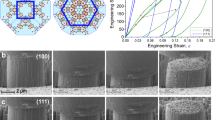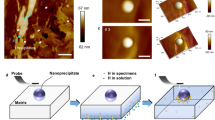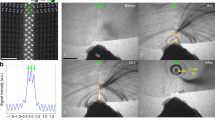Abstract
When metallic alloys are exposed to a corrosive environment, porous nanoscale morphologies spontaneously form that can adversely affect the mechanical integrity of engineered structures1,2. This form of stress-corrosion cracking is responsible for the well-known ‘season cracking’ of brass and stainless steel components in nuclear power generating stations3,4. One explanation for this is that a high-speed crack is nucleated within the porous layer, which subsequently injects into non-porous parent-phase material5. We study the static and dynamic fracture properties of free-standing monolithic nanoporous gold as a function electrochemical potential using high-speed photography and digital image correlation. The experiments reveal that at electrochemical potentials typical of porosity formation6 these structures are capable of supporting dislocation-mediated plastic fracture at crack velocities of 200 m s−1. Our results identify the important role of high-speed fracture in stress-corrosion cracking and are directly applicable to the behaviour of monolithic dealloyed materials at present being considered for a variety of applications.
This is a preview of subscription content, access via your institution
Access options
Subscribe to this journal
Receive 12 print issues and online access
$259.00 per year
only $21.58 per issue
Buy this article
- Purchase on Springer Link
- Instant access to full article PDF
Prices may be subject to local taxes which are calculated during checkout




Similar content being viewed by others
References
Erlebacher, J., Aziz, M. J., Karma, A., Dimitrov, N. & Sieradzki, K. Evolution of nanoporosity in dealloying. Nature 410, 450–453 (2001).
Sieradzki, K. & Newman, R. C. Stress-corrosion cracking. J. Phys. Chem. Solids 48, 1101–1113 (1987).
Ford, P. F. & Andresen, P. L. in Environmental Degradation of Materials in Nuclear Power Systems—Water Reactors (eds Theus, G. J. & Weeles, J. R.) 789–800 (Metallurgical Society, 1988).
Nisbet, W. J., Lorimer, G. W. & Newman, R. C. A transmission electron microscopy study of stress corrosion cracking in stainless steels. Corros. Sci. 35, 457–469 (1993).
Sieradzki, K. & Newman, R. C. Brittle behavior of ductile metals during stress-corrosion cracking. Phil. Mag. A 51, 95–132 (1985).
Rugolo, J., Erlebacher, J. & Sieradzki, K. Length scales in alloy dissolution and measurement of absolute interfacial free energy. Nature Mater. 5, 946–949 (2006).
Cassagne, T. B., Flanagan, W. F. & Lichter, B. D. On the failure mechanism of chemically embrittled Cu3Au single crystals. Metall. Trans. A 17, 703–710 (1986).
Chen, J. S., Salmeron, M. & Devine, T. M. Intergranular and transgranular stress corrosion cracking of Cu-30Au. Corros. Sci. 34, 2071–2097 (1993).
Friedersdorf, F. & Sieradzki, K. Film-induced brittle intergranular cracking of silver-gold alloys. Corrosion 52, 331–336 (1996).
Barnes, A., Senior, N. A. & Newman, R. C. Film-induced cleavage of Ag–Au alloys. Metall. Mater. Trans. A 40, 58–68 (2009).
Sieradzki, K., Kim, J. S., Cole, A. T. & Newman, R. C. The relationship between dealloying and transgranular stress-corrosion cracking of CuZn and CuAl alloys. J. Electrochem. Soc. 134, 1635–1639 (1987).
Serebrinsky, S. A. & Galvele, J. R. Effect of the strain rate on stress corrosion crack velocities in face-centered cubic alloys. A mechanistic interpretation. Corros. Sci. 46, 591–612 (2004).
Snyder, J., Fujita, T., Chen, M. W. & Erlebacher, J. Oxygen reduction in nanoporous metal–ionic liquid composite electrocatalysts. Nature Mater. 9, 904–907 (2010).
Chen, Q. & Sieradzki, K. Spontaneous evolution of bicontinuous nanostructures in dealloyed Li-based systems. Nature Mater. 12, 1102–1106 (2013).
Weissmüller, J. et al. Charge-induced reversible strain in a metal. Science 300, 312–315 (2003).
Kramer, D., Viswanath, R. N. & Weissmüller, J. Surface-stress induced macroscopic bending of nanoporous gold cantilevers. Nano Lett. 4, 793–796 (2004).
Hu, K., Lan, D., Li, X. & Zhang, S. Electrochemical DNA biosensor based on nanoporous gold electrode and multifunctional encoded DNA–Au bio bar codes. Anal. Chem. 80, 9124–9130 (2008).
Stowers, K. J., Madix, R. J. & Friend, C. M. From model studies on Au(111) to working conditions with unsupported gold catalysts: Oxygen-assisted coupling reactions. J. Catal. 308, 131–141 (2013).
Fugita, T. et al. Atomic origins of the high catalytic activity of nanoporous gold. Nature Mater. 11, 775–780 (2012).
Garcia-Gradilla, V. et al. Ultrasound-propelled nanoporous gold wire for efficient drug loading and release. Small 10, 4154–4159 (2014).
Fujita, T. et al. Three-dimensional morphology of nanoporous gold. Appl. Phys. Lett. 82, 251902 (2008).
Li, R. & Sieradzki, K. Ductile–brittle transition in random porous Au. Phys. Rev. Lett. 68, 1168–1171 (1992).
Jin, H-J. et al. Deforming nanoporous metal: Role of lattice coherency. Acta Mater. 57, 2665–2672 (2009).
Jin, H-J. & Weissmüller, J. A material with electrically tunable strength and flow stress. Science 332, 1179–1182 (2011).
Duxbury, P. M., Leath, P. L. & Beale, P. D. Breakdown properties of quenched random systems: The random fuse network. Phys. Rev. B 36, 367–380 (1987).
Freund, L. B. Dynamic Fracture Mechanics (Cambridge Univ. Press, 1998).
Bouchbinder, E., Goldman, T. & Fineberg, J. The dynamics of rapid fracture: Instabilities, nonlinearities and length scales. Rep. Prog. Phys. 77, 046501 (2014).
Goldman, T., Livine, A. & Fineberg, J. Acquisition of inertia by a moving crack. Phys. Rev. Lett. 104, 114301 (2010).
Corcoran, S. G., Brankovic, S. R., Dimitrov, N. & Sieradzki, K. Nanoindentation of atomically modified surfaces. Mater. Res. Soc. Proc. 505, 77–84 (1998).
Angerstein-Kozlowska, H., Conway, B. E., Mamelin, A. & Stoicoviciu, L. Elementary steps of electrochemical oxidation of single-crystal planes of Au—I. Chemical basis of processes involving geometry of anions and the electrode surfaces. Electrochim. Acta 31, 1051–1061 (1986).
Acknowledgements
K.S. thanks L. B. Freund for suggesting the use of the particle velocity equations described in the Supplementary Information for calculating Kdyn. S.S. thanks S. Klein for help with developing the high-speed photography protocols. This work was supported by the US DOE Basic Energy Sciences under award DE-SC0008677.
Author information
Authors and Affiliations
Contributions
S.S. developed the experimental protocols for the high-speed photography and performed all of the measurements on imbibed samples. X.C. performed the dynamic fracture experiments at 1.2 and 1.4 V. N.B. did all tests and analysis involving DIC. K.S. designed and supervised the research and wrote the manuscript.
Corresponding author
Ethics declarations
Competing interests
The authors declare no competing financial interests.
Supplementary information
Rights and permissions
About this article
Cite this article
Sun, S., Chen, X., Badwe, N. et al. Potential-dependent dynamic fracture of nanoporous gold. Nature Mater 14, 894–898 (2015). https://doi.org/10.1038/nmat4335
Received:
Accepted:
Published:
Issue Date:
DOI: https://doi.org/10.1038/nmat4335
This article is cited by
-
Effect of dealloying temperature on microstructure and tensile properties of self-supporting nanoporous copper foil fabricated in situ
Journal of Porous Materials (2023)
-
Fracture toughness and destructive mechanism of ductile nanoporous metallic glass and its crystal-impregnated nanocomposite
Science China Technological Sciences (2023)
-
Liquid metal assisted regulation of macro-/micro-structures and mechanical properties of nanoporous copper
Science China Technological Sciences (2021)
-
Dynamic co-catalysis of Au single atoms and nanoporous Au for methane pyrolysis
Nature Communications (2020)
-
Vapor dealloying of ultra-thin films: a promising concept for the fabrication of highly flexible transparent conductive metal nanomesh electrodes
npj Flexible Electronics (2019)



